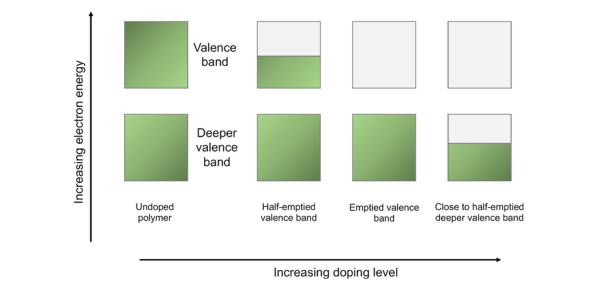Reviewed by Lexie CornerAug 5 2024
In a study published in Nature Materials, scientists at Cavendish Laboratory have found two new approaches to enhancing organic semiconductors.
 Emptying of valence and deeper-valence bands through doping. Image Credit: University of Cambridge
Emptying of valence and deeper-valence bands through doping. Image Credit: University of Cambridge
They discovered a mechanism to extract more electrons from the material than was previously conceivable and leveraged unexpected features in the non-equilibrium state to improve its performance in electronic devices.
We really wanted to hit the nail and figure out what is happening when you heavily dope polymer semiconductors.
Dr. Dionisius Tjhe, Postdoctoral Research Associate, Cavendish Laboratory, University of Cambridge
Doping is the removal or addition of electrons to a semiconductor to increase its capacity to conduct electrical current.
Tjhe and his colleagues explain how these unexpected findings could improve the performance of doped semiconductors.
Energy Bands at Unprecedented Levels of Doping
Electrons in solids are organized into energy bands. The valence band, or highest-energy band, is responsible for several essential physical features, such as electrical conductivity and chemical bonding. Doping in organic semiconductors involves removing a small number of electrons from the valence band. Holes, which are free of electrons, can then flow and carry electricity.
Tjhe added, “Traditionally, only ten to twenty percent of the electrons in an organic semiconductor’s valence band are removed, which is already much higher than the parts per million levels typical in silicon semiconductors. In two of the polymers that we studied, we were able to completely empty the valence band. More surprisingly, in one of these materials, we can go even further and remove electrons from the band below. This could be the first time that’s been achieved!”
Interestingly, the conductivity is substantially higher in the deeper valence band than in the top one.
The hope is that charge transport in deep energy levels could ultimately lead to higher-power, thermoelectric devices. These convert heat into electricity. By finding materials with a higher power output, we can convert more of our waste heat into electricity and make it a more viable energy source.
Dr. Xinglong Ren, Study Co-First Author and Postdoctoral Research Associate, Cavendish Laboratory, University of Cambridge
Why Was This Observed in This Material?
Although the researchers believe that the valence band can be empty in other materials, this effect is most visible in polymers.
“We think that the way the energy bands are arranged in our polymer, as well as the disordered nature of the polymer chains, allows us to do this. In contrast, other semiconductors, such as silicon, are probably less likely to host these effects, as it is more difficult to empty the valence band in these materials. Understanding how to reproduce this result in other materials is the crucial next step. It’s an exciting time for us,” Tjhe added.
Is There Another Way to Increase the Thermoelectric Performance?
Doping increases the number of holes while simultaneously increasing the quantity of ions, limiting power. Fortunately, researchers can use an electrode known as a field-effect gate to regulate the number of holes while leaving the amount of ions unchanged.
Using the field-effect gate, we found that we could adjust the hole density, and this led to very different results. Conductivity is normally proportional to the number of holes, increasing when the number of holes is increased, and decreasing when they are removed. This is observed when we change the number of holes by adding or removing ions. However, when using the field-effect gate, we see a different effect. Adding or removing holes always causes a conductivity increase!
Dr. Ian Jacobs, Royal Society University Research Fellow, Cavendish Laboratory, Dr. Ian Jacobs, Royal Society University Research Fellow at the Cavendish Laboratory
Harnessing the Power of the Non-Equilibrium State
The researchers were able to link these unanticipated effects to a 'Coulomb gap,' a well-known but seldom-seen characteristic in disordered semiconductors. Surprisingly, this impact disappears at room temperature, and the predicted trend is restored.
Jacobs added, “Coulomb gaps are notoriously hard to observe in electrical measurements, because they only become visible when the material is unable to find its most stable configuration. On the other hand, we were able to see these effects at much higher temperatures than anticipated, only about -30 °C.”
Ren stated, “It turns out that in our material, the ions freeze; this can happen at relatively high temperatures. If we add or remove electrons when the ions are frozen, the material is in a non-equilibrium state. The ions would prefer to rearrange and stabilize the system, but they can’t because they are frozen. This allows us to see the Coulomb gap.”
Usually, there is a trade-off between thermoelectric power production and conductivity, with one increasing and the other decreasing. However, due to the Coulomb gap and non-equilibrium effects, both can be raised simultaneously, resulting in greater performance.
The sole constraint is that the field-effect gate can currently only impact the material's surface. If the mass of the material can be altered, the power and conductivity will increase much more significantly.
Though the group still has more work to do, the research study offers a clear approach to improving the performance of organic semiconductors. With promising opportunities in the energy sector, the company has kept the door open for future investigation of these properties.
Tjhe concluded, “Transport in these non-equilibrium states has once again proved to be a promising route for better organic thermoelectric devices.”
Journal Reference:
Tjhe, DHL., et. al. (2024) Non-equilibrium transport in polymer mixed ionic–electronic conductors at ultrahigh charge densities. Nature Materials. doi:10.1038/s41563-024-01953-6